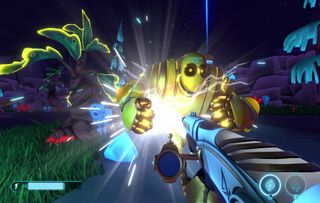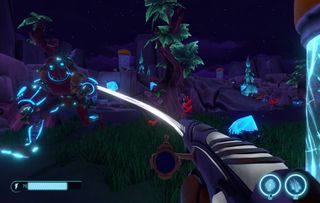Aftercharge is a multiplayer FPS where one side can't die
Invisible robots punch invincible guards.

I haven’t punched anything in nearly a minute. That’s bad, because I need to punch things in order to win. My inaction leaves me invisible to the enemy team, and that’s good, because I need to stay out of sight to maneuver around. The three opposing guards, clad head to toe in hazard gear seemingly pilfered from the Team Fortress 2 Pyro’s closet, huddle around their last glowing energy generator which, following established logic, needs to be punched. My two robot teammates jump up and down beside me in the universal signal to start a play. I circle around, not wanting to risk detection with a frontal assault. As I inch closer, I’m ignorant of the soft beeping coming from an EMP mine nestled in the grass beneath my metal toes. Zap. I’m jolted out of stealth, and three begoggled heads whip around, pistols and rifles following suit to draw a bead on my shiny doomed noggin. I take a crazy amount of firepower and drop heroically to the dirt, my vision fuzzing out to signify my disabled status. I hear the tinkling of muzak. The punchline is clear: I’m out of service.
Aftercharge comfortingly reminds me of a handful of other games. Its stealth-on-shooting design evokes that of Splinter Cell’s excellent Spies vs. Mercs mode. The juxtaposition of melee against ranged attacks echoes Evolve’s take on engagement distances. Its emphasis on small-scale teamwork with sudden bursts of action mirrors a pacing adoringly lifted from Left 4 Dead’s Versus rhythm. The early vertical slice I played conveyed all of these influences through just a single map and a couple work-in-progress classes, an impressive start to developer Chainsawesome Games’ contribution to the steady rise of asymmetrical shooters.
Wreck ‘em bots
Approachability anchors Aftercharge. A 3v3 setup pits a trio of robots against a squad of human guards. The robots are unarmed, but they’re always invisible unless they get too close, punch something, or become revealed by the guards’ abilities. The guards are invincible, and they’re packing rifles, pistols, and detection equipment such as EMP grenades and airstrike markers, but they need to draw energy from the six extractors peppering the map to power their weapons. The robots need to get close and destroy each extractor to win, while the guards can disable all three robots to secure a victory themselves. As the extractors dwindle, so does the mobility of the guard team, and the final moments of a round frequently climbed in tension and chaos when battling over a final extractor.
It’s easy to feel an initial doubt of overpowering situations, but central to Aftercharge’s hook is how the contrasting strategies of each side balances against the baseline boon of not being seen or not worrying about death. The latter in particular presents a profoundly interesting spin on one of the fundamental pillars of shooters, and even the robots can mitigate casualties by quickly reviving fallen teammates. That in turn underscores the need for the guards to divide their attention between monitoring active extractors and keeping an eye on robot bodies.

I felt most comfortable with the Liquidator class on the guard side, a dual-pistol hunter of sorts who can shoot a tracker on a robot acts as a homing beacon for about six shots regardless of aim and even if my target was invisible. He could also use some energy to lay down the aforementioned proximity mine, and I greatly enjoyed trapping sharp corners and small passages between rocks to warn me of any movement. The other guard class, the Striker, felt more oriented for defense with his slower-firing rifle, EMP grenade, and tossable airstrike marker. His wider area coverage comes at the cost of a higher energy draw, so I often perched myself near an elevated extractor for a higher vantage point to make use my rifle’s longer range.
Each class ability encourages a wide range of both large and small tactics without being overshadowed by an overriding mechanic like Overwatch’s ultimates.
The robots adopt a more straightforward concept of having their fists do most of the work, but they can spend some energy—their hit points, in this case—to “overcharge” each other with useful defense and distraction abilities. Flick, for example, can land a close-range electric discharge that sends guards flying and saps a portion of their energy. The spindly Bubbles can place a spherical shield that absorbs gunfire and protects teammates within. Punching extractors restores energy, but the bots can only withstand a few hits before switching off in a heap.
Brainpower
What I enjoy most from Aftercharge so far is how each class ability encourages a wide range of both large and small tactics without being overshadowed by an overriding mechanic like Overwatch’s ultimates. As a guard, I could bump into disabled robots and move them into a disadvantageous position for their teammate to attempt a revive. As the robots, my team achieved a speedy one-minute victory when I tried staying out of sight and only reviving allies for a round. Guards are limited in their movement; they need to always be aware of the closest extractor to recharge. Robots have to juggle the luxury of stealth with the vulnerability of revealing themselves to strike or overcharge a teammate. I appreciated how countering relied more on effective strategy and coordination over well-timed ability use, and there’s great potential for outsmarting unlikely odds with good movement, a sharp eye, and a tact for misdirection.
The biggest gaming news, reviews and hardware deals
Keep up to date with the most important stories and the best deals, as picked by the PC Gamer team.

My lingering concern for Aftercharge centers on its balance and viability for each robot and guard class in the long-term. The absence of cooldowns on the guard abilities means a high chance of spammy fire and grenades sprinkling the map at a constant rate. Bubbles' shield was far more useful than Flick's blast, as I could simply punch away a guard for the same knock-away effect. Robots can chain-revive their way to victory, and there wasn’t much downside to leapfrogging suicide runs into the final extractor if one robot lingered behind as a medic.
Still, I felt neither completely useless nor godlike during my session, and I chalk that up to the splendid dedication Chainsawesome Games has shown so far to keeping its game fair. There are plans to further cultivate Aftercharge when it releases in early 2018, including a competitive mode, cosmetic microtransactions, maps with more verticality and theme variety, and classes with different health amounts and movement speeds. For now, I’m content to punch things.
Omri Petitte is a former PC Gamer associate editor and long-time freelance writer covering news and reviews. If you spot his name, it probably means you're reading about some kind of first-person shooter. Why yes, he would like to talk to you about Battlefield. Do you have a few days?
Most Popular

